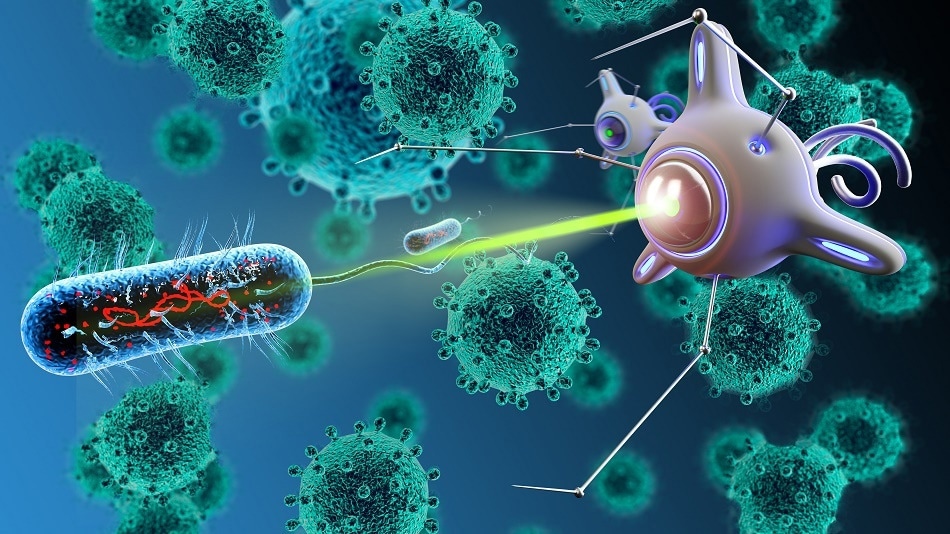Nanotechnology is evolving rapidly in industrial applications, medical imaging, disease diagnosis, drug delivery, cancer treatment, and gene therapy, and also to aid in visual imaging. Nanotechnology is at the cutting edge of rapid healthcare product development as it has many potential human health benefits, but it is perceived with some apprehension for its potential human health risks.
Many fine particles currently considered harmless are likely to acquire unique properties when reduced to a nano molecular size and could exhibit toxic biological effects. It is known that toxicity of engineered NP will depend on the physical and chemical properties of the particle. Nanomaterials can have different properties from the same material that is not within the nanoscale. The size of the NP is important when determining the toxicity of the NP as well as the surface area of, agglomeration state, crystal structure, surface charge and porosity.

Image Credits | shutterstock.com/g/gorbovoi81
Positive Impact
There are many unique health benefits of nanoparticles; molecular imaging uses nanoparticles which help to detect, quantify, and display molecular and cellular changes that happen in vitro and in vivo. Fluorescent biological probes using organic dyes are used conventionally in biology because of their inert qualities and their ability to interact without loss of sensitivity in a variety of cellular reactions.
In vivo, nanoparticles can be used as probes by attaching them to molecules of proteins, antibodies, and nucleic acids. These nanoparticles can then be used as tools for displaying and quantifying molecular reactions inside the body. They have high photostability, high levels of brightness and absorption coefficients across a broad spectral range.
Site-specific-targeted drug delivery using nanoparticles is more effective for improved bioavailability, minimal side effects, decreased toxicity to other organs and is less costly.
An exciting potential use of nanoparticles in cancer treatments is the exploration of tumor-specific thermal scalpels to heat and burn tumors. By using near infrared-absorbing polyethylene-coated gold nanoshells of 130 nm, it can be used to inhibit the growth of a tumor.
Gold and silver nanoparticless have strong antifungal, antibacterial and anti-inflammatory properties and are used in anti-wrinkle creams, deodorants and burn medications. They are inert, highly stable, biocompatible and non-cytotoxic.
We have come across many health benefits of nanotechnology. But do we know that these NPs can also have an adverse effect on our health, depending on the exposure and quantity?
Negative Impact
Toxicity of nanoparticles depends on their surface properties, coating, structure, size, and ability to aggregate. If nanoparticles have poor solubility they can cause cancer. This is because the nanoparticles have a greater surface area to volume ratio which increases the chemical and biological reactivity.
The nanoparticles can enter the body through many routes; dermally, by ingestion, inhalation, injection or by implantation. Nanoparticles enters dermally when they are present in skin care products, hair products or lip balms including sunscreens and anti-wrinkle cream.
The cosmetic products need no clinical trials but have the maximum number of products with nanoparticles. The nanoparticles in these products have been reported to cause erythema, the cobalt and chromium nanoparticles cross skin barrier and damage fibroblasts.
Many mechanisms have been proposed to explain the adverse effects which may lead to cardiopulmonary morbidity and mortality in populations exposed to nanoparticles. Nanoparticles can stimulate the neurons in the lung affecting the central nervous system and cardiovascular autonomic function. When NPs gain access to the circulation, they can trigger an acute inflammatory reaction, as these particles are recognized and identified by the immune system of the body as “invader” particles. The immune system starts releasing cytokines which is a chemical substance usually released whenever the body is exposed to foreign materials. These particles cause a reaction in the lung same as any pollutant or inflammatory substances, sometimes also affecting the reactive oxygen species (ROS), in extreme situations can trigger cardiac events.
Remedial Solution
Every scientist using Nanoparticles or being exposed to them should use protection such as a masks, gloves etc. while working with the nanomaterials. They should also be careful about the disposal of these materials once experiments are completed to ensure that these harmful particles do not enter the environment and exacerbate the new classification of pollution, nanopollution.
WHO has already listed a series of health implications on exposure to NPs. But how large is the risk and what should the regulation and policies be that have not yet been formulated.
Current evidence is not conclusive. Different models and frameworks for risk estimation are being developed to organize the available data on the health effects of nanomaterials and methods to incorporate them into a policy.
Many countries are yet to have regulation in place regarding usage of nanoproducts whether in cosmetics, drugs, implants, food packaging or others. It is important to use regulatory mechanisms and laws during production and usage of nanomaterials.
Sources
1. https://www.who.int/europe/home?v=welcome
2. https://www.sciencedirect.com/science/article/pii/B9780128136294000164
3. http://www.packaginglaw.com/special-focus/nanotechnology-regulation-food-packaging
4. Xia, Tian, Ning Li, and Andre E. Nel. "Potential health impact of nanoparticles" Annual review of public health 30 (2009): 137-150.
5. Teow, Yiwei, et al. "Health impact and safety of engineered nanomaterials." Chemical communications 47.25 (2011): 7025-7038.
Disclaimer: The views expressed here are those of the author expressed in their private capacity and do not necessarily represent the views of AZoM.com Limited T/A AZoNetwork the owner and operator of this website. This disclaimer forms part of the Terms and conditions of use of this website.